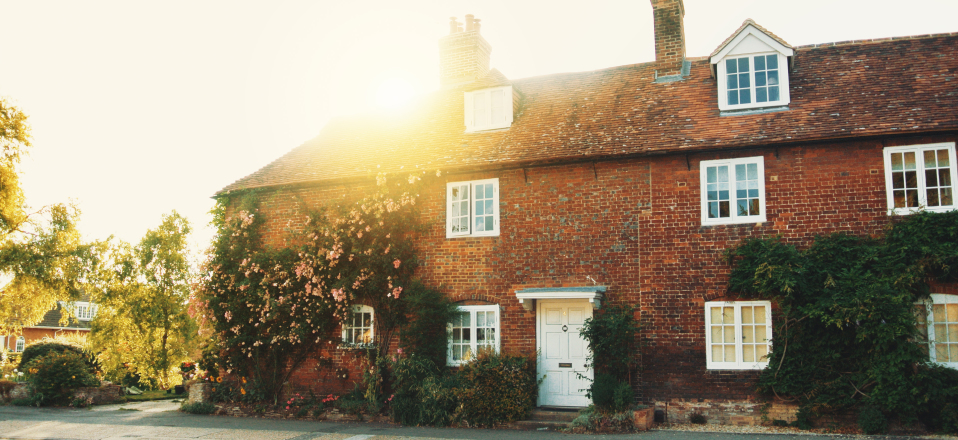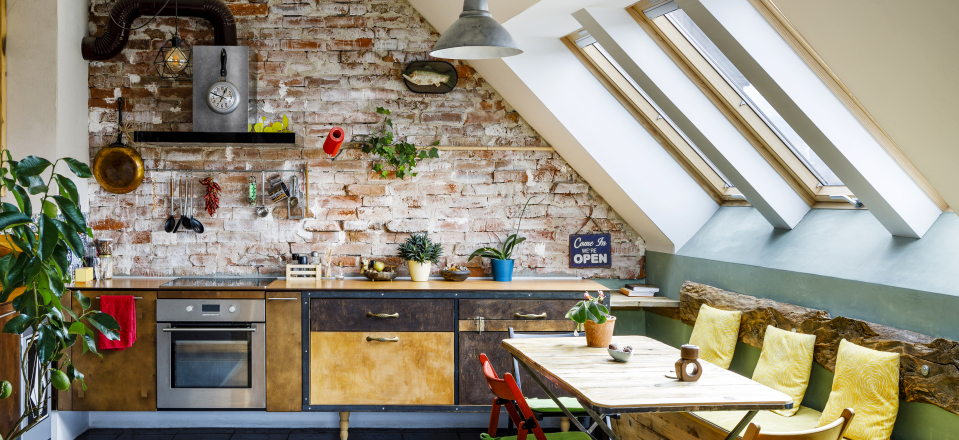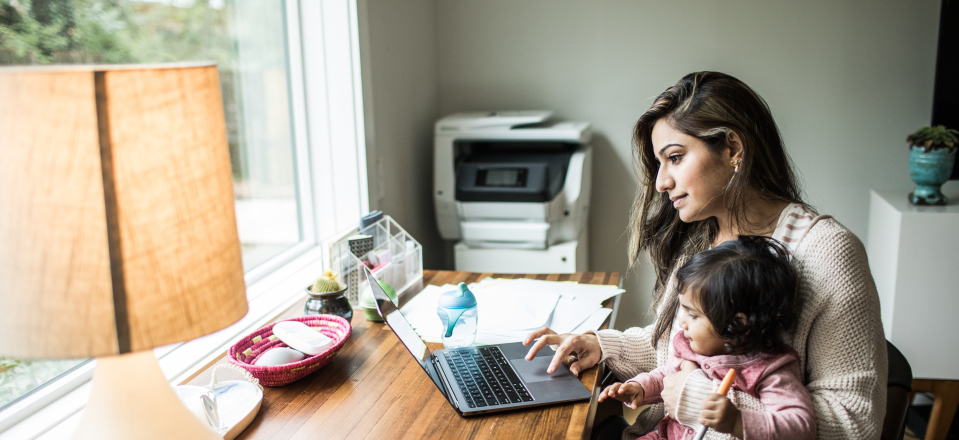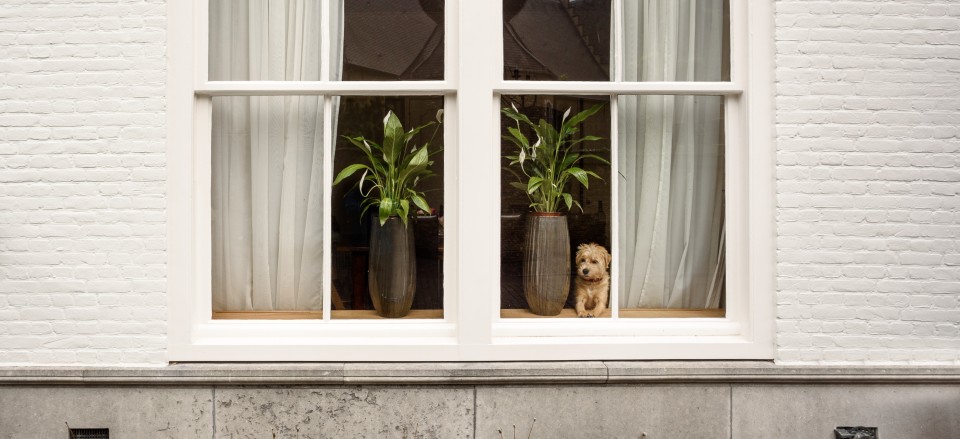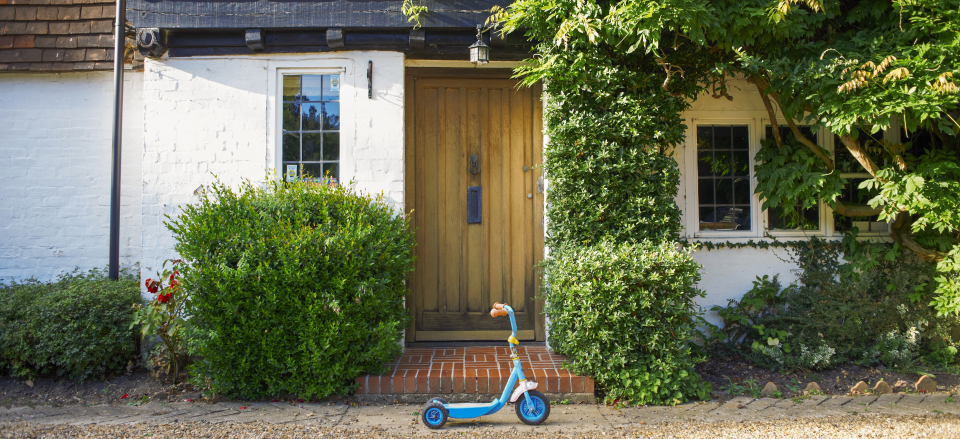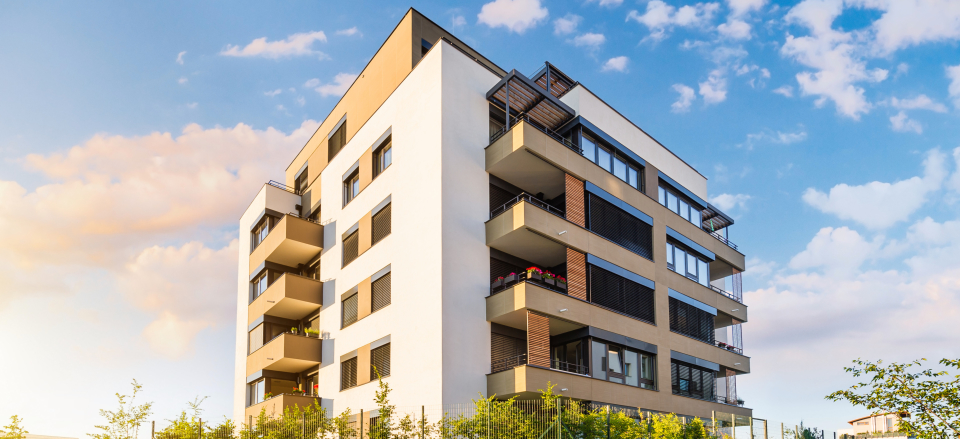Revealed: where family homes have seen the biggest jump in value
Searching for a home with more space? Find out how three to five-bedroom houses are performing in different areas.
Family homes in the Midlands have seen the biggest jump in value during the past four years.
The East Midlands ranks in first place, with the price per sq ft of a family home in the region increasing by 25.4%, or £43, since 2016 to stand at £212.
Meanwhile, the West Midlands comes in second place. The price per sq ft of a family home, defined as a three to five-bedroom house, has risen by 24.6% to £223, according to our data.
Price per sq ft measures the ratio between property value and size. In other words, it offers a base line for comparing the cost of homes without having to make adjustments for the different sizes of properties.
Wales comes in third, with a 23.6% hike in prices per sq ft, followed by those in the east of England and the north west, with gains of 21.4% and 21.3% respectively.
The cost of a three to five-bedroom house has increased by 20.8% in the past four years in the south west, 20.3% in Yorkshire and the Humber, and 16.7% in the south east.
London, which comes in ninth place, saw the biggest increase in values per sq ft in monetary terms, with a jump of £71 to an average of £558. However, in percentage terms the rise was only 14.6%.
Scotland and the north east saw the lowest gains in property values on a per sq ft basis, at 14.5% and 9.6% respectively.
Which local authorities saw the highest growth?
At a local authority level, Merthyr Tydfil, just south of the Brecon Beacons National Park in Wales, saw the biggest increase in prices per sq ft, with a jump of 38.2%, or £34, during the past four years to leave the average family home there costing £123 per sq ft.
The Forest of Dean, in the south west, was not far behind with a 37.9%, or £64, rise in prices per sq ft to £233, followed by Tameside in the north west at 35.9%, or £52, to £197.
Nottingham and Birmingham completed the top five, with house prices per sq ft rising by 34.8% and 34.1% respectively during the period.
Overall, six of the local authorities that saw the biggest price increases were in the East and West Midlands.
What's the background?
The coronavirus pandemic is prompting many people to carry out a once-in-a-lifetime re-evaluation of their housing needs.
Successive lockdowns, combined with an increase in people working from home, is driving people to look for homes with more space. And demand for family houses with gardens, parking and extra space to work has intensified.
Our research shows people who are looking for more space, such as those with growing families, how three to five-bedroom houses are performing in terms of value.
Mortgage choice jumps to 11-month high
Borrowers now have the greatest number of mortgages to choose from since the first national lockdown came into force last March.
Mortgage choice has reached its highest level for 11 months as lenders launch a raft of new deals.
There are currently 3,215 mortgages to choose from, such as fixed rate and tracker mortgages, with different terms, interest rates and incentives.
That’s the highest number since March 2020, when the first national lockdown came into force. There were 5,222 mortgages in the market at that point.
And since October, the number of mortgages available has increased by 42%, the biggest four-monthly rise in choice since 2007, according to financial information group Moneyfacts.
Why is this happening?
Mortgage choice fell sharply in the first half of 2020, as lenders withdrew their mortgages while they reassessed the level of risk that they were prepared to take in the face of the Covid-19 pandemic.
Borrowers with only small deposits were hit particularly hard, with nine out of 10 mortgages for people borrowing 90% of their home’s value withdrawn between March and the end of June.
But the fact that choice is improving again, particularly for people with small deposits, suggests lenders are now less risk averse, while stable interest rates point to increased competition in the market.
Who does it affect?
First-time buyers
There was good news for first-time buyers, with the number of mortgages available to people with just a 10% deposit rising to 248, 88 more than in January.
First-time buyers have not only seen an increase in product choice, with the number of deals available for those with a 10% deposit nearly quadrupling during the past four months, but interest rates on the mortgages have also fallen.
In a further sign that competition is returning to this sector of the market, the average cost of a two-year fixed rate loan for someone borrowing 90% of their home’s value fell by 0.09% during the past month, while the cost of a five-year fixed rate deal dropped by 0.07%.
Despite these improvements, choice remains very limited for people with only a 5% deposit, with just five deals currently available, down from eight in January.
Existing homeowners
There is also good news for home-movers and people looking to remortgage, as the number of different deals available to choose from has increased significantly, with nearly 500 different mortgages available for people borrowing 60% of their home’s value.
The cost of a mortgage has also fallen for people with large equity stakes of at least 40% in their home.
After being on a steady upward trajectory during much of the second half of last year, interest rates charged on a two-year fixed rate mortgage for these borrowers have dropped by 0.05%, while rates on five-year fixed rate deals have fallen by 0.07%.
What’s the background?
In a further sign that the mortgage market is stabilising after a turbulent year, the number of days for which individual mortgages are available before lenders withdraw them rose from 28 days in January to 40 days.
The move is good news for potential borrowers as it gives them a better chance to secure the deal they want before lenders replace it with a different offer.
Eleanor Williams, finance expert at Moneyfacts, said: “This, coupled with overall average rates remaining quite static and availability continuing to improve, could imply the mortgage market is now the most stable it has been since the onset of the pandemic last year.”
Top three takeaways
- Mortgage choice has reached its highest level for 11 months as lenders launch a raft of new deals
- There are 3,215 different mortgages to choose from, a 42% increase since October
- The number of mortgages available to people with just a 10% deposit rose to 248, 88 more than in January
Rental demand soars in commuter belts
Our latest rental market report reveals tenants are looking for larger homes outside of city centres.
The search for space in the face of the Covid-19 pandemic is driving a mini-boom in the rental market, pushing rents higher, our latest Rental Market Report shows.
The ‘once in a lifetime’ reassessment of housing needs seen in the sales market is also influencing the rental one, as people look for larger properties in commuter zones or well-connected towns.
The rise in demand in these areas is pushing rents higher, with the average cost of being a tenant in the UK, excluding London, increasing by 2.3% year-on-year, putting rents back to pre-Covid levels.
Overall demand has risen by 21%, with houses letting 30% quicker than they were 12 months ago.
Despite these increases, affordability remains fairly stable, and you will need an average of 32% of your salary to cover your rent.
What’s happening in commuter areas?
.png)
A halo effect has emerged in the wider commuter zones of the UK’s largest cities as tenants look for more space, both indoors and outdoors.
Rents in well-connected towns have registered strong growth, rising by 8.2% in Rochdale, 8% in Hastings, and 5.8% and 5.5% in Southend and Newport in Wales respectively.
By contrast, the easing in demand in cities across the UK has led to a slight softening of rents in these locations, with rents dropping by 1.8% in Edinburgh year-on-year, while they are 0.9% lower in Greater Manchester and 0.8% down in Greater Birmingham.
As a result, if you are coming to the end of your current lease in a city centre, you may be able to make some savings by finding a new property.
But while rents in central Birmingham fell by 3.4% year-on-year, the cost of being a tenant in the surrounding boroughs of Bromsgrove, Sandwell and Wolverhampton has risen by an average of 5%, buoyed by demand from renters who no longer need to commute on a daily basis.
If you are looking to move into a commuter area, be sure to shop around to make sure you secure the best rental deal.
You should also be prepared to move quickly, especially if you are looking for a family home, as these are being snapped up.
.png)
Try to build up a rapport with local agents in your preferred area, so that they can alert you when new listings that meet your criteria come on to the market.
What’s happening in London?
.png)
The impact of Covid-19 on the rental market has been amplified in London, with demand for properties in the capital down 10% year-on-year, on the back of working from home policies, reduced international travel and close to zero tourism.
These factors have led to rents in Greater London dropping by 8.3%, the steepest annual fall since the Global Financial Crisis.
But this fall is being exaggerated by declines in higher value, dense rental markets, such as Kensington and Chelsea.
By contrast, several outer London boroughs are still reporting rental growth, with the cost of being a tenant rising by 2.6% in the past year in Havering and by 1.1% in Enfield.
At the same time, the downturn in London rents is showing signs of easing, edging down by just 0.4% in December, the smallest monthly reduction since February 2020.
Meanwhile, new supply in London is up 30% year-on-year, creating more choice for potential tenants and exerting downward pressure on rents.
What’s the outlook?
.png)
The outlook for the rental market depends to a large extent on how quickly a vaccine can reduce the impact of Covid-19 and enable normal business activity to resume, particularly in city centres.
Even then, flexible working is likely to continue, meaning there may be a permanent shift in priorities for some renters.
The demand for space is unlikely to diminish any time soon, which will continue to support the rental market for family homes.
Overall, the uncertainty created by the pandemic, rising unemployment and limited mortgage availability for buyers with small deposits will continue to drive demand for rented homes.
This demand, combined with a lack of new supply nationally, will support rental growth in the long run.
Our head of research, said: “Changing working, commuting and tourism patterns were felt very quickly in the central London rental market.
“Now we are seeing the impact in other city centres, although on a more modest scale. Balancing the rental declines in inner cities is the strong rise in rental growth in surrounding ‘halo’ areas and well-connected towns across the UK, reflecting stronger demand in many of these markets among a cohort of renters.
“Yet it is important to note that most demand among renters living in central cities is within the same area - some renters will have ties to an area through schooling, or non-office-based work.”
Revealed: how long it's taking buyers to complete in 2021
With housing transactions taking longer than normal to wrap up, find out how you can improve your chances of beating the stamp duty holiday deadline.
The average time it takes for a home sale to cross the line is now just under four months – around a fortnight longer than normal.
Most buyers who agreed a sale in 2020 would have expected to complete by 31 March 2021 under usual circumstances, according to our House Price Index.
However, the average time for an agreed sale to complete has surged from 90 days to 110-115 days.
Why are sales taking longer to complete?
The housing market was one of the bright spots of the economy last year, with 47% more sales agreed in the second half of the year than the same period in 2019. And this has led to a congested sales pipeline.
The stamp duty holiday, introduced last July, has boosted buyer appetite to move home.
The temporary tax break means that nearly nine out of 10 transactions are no longer subject to stamp duty, with the average bill falling by £4,500.
It’s set to run until 31 March, and with savings of up to £15,000 on offer, many buyers are now racing to beat the deadline.
The pandemic has prompted many people to carry out a once-in-a-lifetime re-evaluation of their home too, stimulating home moves and driving a search for space.
What does this mean if you’re hoping to take advantage of the stamp duty holiday?
There is a risk that up to 70,000 sales agreed in 2020 may miss the stamp duty holiday deadline, assuming a four-month completion period, according to our House Price Index.
What is not clear is how many buyers are dependent on the stamp duty holiday.
The more buyers rely on securing the tax break, the greater the risk of a spike in sales falling through if they don’t make the deadline.
If a stamp duty holiday extension fails to materialise, buyers across some housing chains may help to fund stamp duty costs for others in the chain to safeguard completions.
However, first-time buyers will still be able to make a saving after the deadline because under standard rules, they don’t pay any stamp duty on the first £300,000 on homes worth up to £500,000.
What can you do to improve your chances of securing the stamp duty holiday saving?
It’s all about getting prepared now to reduce potential delays.
From getting your paperwork in order, to setting realistic timelines, there are always ways to keep your keep your purchase on track. Check out our top tips for a smooth property transaction.
If you're in a property chain, it’s also worth getting your head around how to manage them. Our guide on how to keep your property chain intact is a handy read.
Your conveyancer plays a key role in the buying process. Our 10-step guide shows you exactly what you’re paying for and how they can help you.
Finally, don’t let industry jargon trip you up. Look up terms you don’t understand in our property jargon buster.
Could the government extend the stamp duty holiday?
While the government will be keen to start raising tax revenues once again, the case for a short, month-long stamp duty extension is growing, to help buyers who agreed a sale in 2020 to complete.
Around 55% of sales agreed in January would complete by the end of March in a normal year – but the proportion this year is likely to be lower.
A petition calling for the stamp duty holiday to be extended has received more than 100,000 signatures, triggering a debate to be held in Parliament.
Responding on behalf of the government, financial secretary to the Treasury, Jesse Norman, said that he could not comment on tax policy outside of a fiscal event, such as a Budget.
He added: “The government will continue to listen carefully to representations from the industry and from those who are planning to buy or sell a property.”
Mortgage approvals hit 13-year high in 2020
The pandemic has fuelled a lot of home moves, buoyed by Rishi Sunak’s stamp duty holiday.
The number of mortgages given the green light soared to a 13-year high in 2020 despite successive lockdowns.
A total of 818,500 mortgages were approved for people buying a home last year, the highest level since 2007.
The increase came despite the level of pipeline loans - in other words, mortgages that have been given the go-ahead but the money has not yet been released - slumping to a record low of 9,400 in May. The housing market bounced back in the second half of the year, according to the Bank of England.
But there are signs that the boom is starting to slow, with the number of mortgages approved in December dropping slightly compared with November’s figure, as the end of the stamp duty holiday looms.
Why is this happening?
Disruption caused by the first national lockdown in March, which saw the housing market shut down temporarily, led to a sharp fall in property transactions.
But the market took off again once restrictions were lifted, unleashing pent-up demand and causing people to carry out a once-in-a-lifetime re-assessment of their housing needs.
At the same time, the stamp duty holiday prompted many people to bring forward purchases in order to benefit from the tax break.
Who does it affect?
It’s good news generally for people needing a loan to move home.
Sales were agreed on more than £300bn worth of property last year, that's 26% higher than in 2019, according to our House Price Index.
But first-time buyers struggled during 2020, as lenders withdrew their low-deposit mortgages.
What’s the background?
With a third national lockdown now in place, would-be sellers appear to have paused in listing their homes for sale, according to our House Price Index.
However, the pandemic continues to fuel buyer appetite, buoyed by a last-minute stamp duty deadline rush.
The mismatch between supply and demand could put further upward pressure on prices, but the shortage of homes on the market is likely to lead to a dip in transactions.
There have been calls for the government to extend the stamp duty holiday to provide further support to the market, but it has so far ruled out doing so.
Top three takeaways
- The number of mortgages approved soared to a 13-year high in 2020 despite successive lockdowns
- The increase came despite the level of pipeline loans slumping to a record low of 9,400 in May
- There are signs the boom is starting to slow, with mortgages approvals dropping slightly in December
MPs debate stamp duty holiday
With the stamp duty holiday due to end on 31 March, Parliament has debated an extension. Here’s what it means if you’re planning to buy or sell a home.
A petition calling for the stamp duty holiday to be extended has received more than 100,000 signatures, triggering a debate to be held in Parliament.
Responding on behalf of the government, financial secretary to the Treasury, Jesse Norman, said that he could not comment on tax policy outside of a fiscal event, such as a Budget.
He added: “The government will continue to listen carefully to representations from the industry and from those who are planning to buy or sell a property.”
Chancellor Rishi Sunak announced in July last year that homes costing up to £500,000 would be exempt from the tax.
It is estimated that nine out of 10 people purchasing a property since the announcement have not had to pay stamp duty, saving an average of £4,500 each.
But as the 31 March deadline for the end of the holiday looms, there have been industry calls for it to be extended.
Responding in December to the petition, the government said: “As the relief was to provide an immediate stimulus to the property market, the government does not plan to extend this relief.
“Stamp duty is an important source of government revenue, raising several billion pounds each year to help pay for the essential services the government provides.”
What’s the background?
The stamp duty holiday was introduced by Sunak in a bid to boost the housing market in England and Northern Ireland during the coronavirus pandemic.
Under normal circumstances, buyers pay stamp duty land tax when buying a property worth £125,000 or more, although first-time buyers only have to pay it on homes above £300,000.
The introduction of the stamp duty holiday raised the threshold at which the tax kicks in to £500,000 for all buyers, amounting to a potential saving of up to £15,000.
Can I still buy before the stamp duty holiday ends?
Yes, but you’ll need to move fast. The time it takes between agreeing a sale and completing is normally just under 100 days.
Our research shows that only 54% of sales agreed in January will complete in time, with that figure dropping to 17% in February.
From getting your paperwork lined up in advance, to smoothing out any wrinkles that may disrupt your property chain, here are our top tips to help you beat the deadline.
What happens when the stamp duty holiday ends?
Once the stamp duty holiday ends on 31 March next year, the former stamp duty rules will apply.
This means buyers can be charged between 2% and 12% tax (or up to 17% if they are a foreign investor) on their property purchase, depending on the value of the home they are buying and if they own more than one property.
“The government is committed to supporting home ownership and helping people get on and move up the housing ladder,” it said.
“When the stamp duty holiday ends, the government will maintain a stamp duty relief for first-time buyers which increases the starting threshold of residential stamp duty to £300,000 for first-time buyers that purchase a property below £500,000."
How much stamp duty will I pay after 31 March 2021?
Stamp duty is calculated as a percentage of the property you are buying. It applies to freehold and leasehold properties, whether you’re buying outright or with a mortgage.
For existing homeowners, the rates are:
-
0% up to £125,000
-
2% on £125,001-£250,000
-
5% on £250,001-£925,000
-
10% on £925,001-£1.5m
-
12% on any value above £1.5m.
For example, if you buy a flat for £275,000, the stamp duty you owe would be:
-
0% on the first £125,000 = £0
-
2% on the next £125,000 = £2,500
-
5% on the final £25,000 = £1,250
Total stamp duty = £3,750
First-time buyers after 31 March 2021
Stamp duty relief was introduced in November 2017 for first-time buyers to help people step onto the property ladder.
First-time buyers are exempt from stamp duty on properties costing up to £300,000 and pay 5% on the value of a property between £300,000 and £500,000.
A first-time buyer will pay:
-
0% on the first £300,000
-
5% on the remainder up to £500,000
So a first-time buyer purchasing a £275,000 flat would pay no stamp duty.
For a house costing £475,000, a first-time buyer would pay:
-
0% on the first £300,000 = £0
-
5% on the final £175,000 = £8,750
Total stamp duty = £8,750
However, if the purchase price is more than £500,000, first-time buyers cannot claim the relief and must pay the standard rates.
For example, a property purchased at £700,000 would result in a stamp duty bill totalling £25,000 even for a first-time buyer.
Landlords and second-home owners
For owners of more than one property, a surcharge of 3% on top of the standard stamp duty rates apply.
However, if you sell a home within three years of purchasing a second property, you can apply for a refund of that 3%.
It is also possible under some circumstances to claim multiple dwellings relief.
What about non-UK residents?
From April 2021, an additional 2% stamp duty levy will be imposed on non-UK residents who buy property in England and Northern Ireland.
It means that international buyers of second homes could pay up to 17% tax on expensive properties.
The 2% is on top of standard rates and in addition to the 3% surcharge for any investors who own property elsewhere.
What other government support is available?
During the second lockdown, the government extended its offer of mortgage payment holidays. Those who need help paying their mortgages can still request a holiday of up to six months until 31 March 2021.
To help first-time buyers get on the property ladder, the government's Help to Buy scheme offers an equity loan of up to 20% of the property value (40% in London). As long as you can raise a 5% deposit, you can then apply for a standard mortgage to pay the remaining amount.
At the Conservative party conference in October, Prime Minister Boris Johnson pledged to “turn generation rent into generation buy” and announced plans for a new scheme to give more people the chance to take out long-term fixed rate mortgages for up to 95% of their home’s value - although details have not yet been released.
What about stamp duty in Scotland and Wales?
Housing is a devolved issue in Britain so stamp duty only applies in England and Northern Ireland.
Scotland and Wales have equivalent taxes:
Scotland
From April 2015, Stamp Duty was replaced by Land and Buildings Transaction Tax (LBTT) in Scotland.
In Scotland, the LBTT rates are:
-
0% up to £145,000
-
2% on £145,001-£250,000
-
5% on £250,001-£325,000
-
10% on £325,001-£750,000
-
12% on any value above £750,000
First-time buyers pay no LBTT up to £175,000.
Wales
Property owners in Wales have paid Land Transaction Tax (LTT) since April 2018.
LTT rates are:
-
0% up to £180,000
-
3.5% on £180,001-£250,000
-
5% on £250,001-£400,000
-
7.5% on £400,001-£750,000
-
10% on £750,001-£1.5 million
-
12% on any value above £1.5 million
In December, the Welsh government introduced an additional charge for second-home owners.
Second home-owners will now pay a 4% levy when they buy homes up to £180,000, rising to 16% for homes worth £1.6m or above.
Government makes it easier for renters with pets to secure homes
Responsible renters with well-behaved pets to secure leases more easily through Government's new tenancy agreement.
A new standard tenancy agreement introduced by the government will make it easier for tenants with pets to find rented accommodation.
Under the new Model Tenancy Agreement agreed last week, responsible tenants with well-behaved pets will be able to secure leases more easily, as consent for pets will now be the default position.
The Model Tenancy Agreement is the government’s recommended contract for landlords.
With figures showing that more than half of adults in the UK own a pet and many more are welcoming pets into their lives during the pandemic, these changes mean more landlords will cater for responsible pet owners.
What are the current rules for renting with pets?
With few private landlords currently advertising pet friendly properties (only 7%), many people with pets have struggled to find suitable homes. In some cases, this has meant they have had to give up their pets altogether.
Landlords have been able to issue a blanket ban on pets, inserting clauses into their tenancy agreements to state that renters cannot keep them.
If a pet is allowed, the landlord may also put in additional clauses to the tenancy agreement related to owning a pet, such as making sure it doesn’t foul in the garden or inside the property, not leaving it alone in the property for too long and cleaning the property thoroughly before the end of the tenancy.
Any damage to the property or extra cleaning that needs to be undertaken should be dealt with by the tenant. If it isn't, the landlord may deduct these costs from the tenant's deposit at the end of the tenancy.
Will the new Model Tenancy Agreement make it easier to rent with pets?
The new tenancy agreement isn't legally-binding, but the government hopes landlords will adopt it. Through these changes, landlords will no longer be able to issue a blanket ban on pets.
If the landlord objects to the tenant having a pet, that rejection should only be made where there is good reason, such as in smaller properties or flats where owning a pet could be impractical. It should also be given in writing, within 28 days of a written pet request from a tenant.
To ensure landlords are protected, tenants will continue to have a legal duty to repair or cover the cost of any damage to the property.
A responsible pet owner will be aware of their responsibilities in making best efforts to ensure their pet does not cause a nuisance to neighbouring households or undue damage to the property.
Landlords will be prohibited from charging a fee to a tenant who wishes to keep pets or other animals at the property. However, permission may be given on the condition that the tenant pays an additional reasonable amount towards the deposit (as long as this doesn't breach the deposit cap requirements under the Tenant Fees Act 2019).
Housing Minister Rt Hon Christopher Pincher MP said: “We are a nation of animal lovers and over the last year more people than ever before have welcomed pets into their lives and homes.
“But it can’t be right that only a tiny fraction of landlords advertise pet friendly properties and in some cases people have had to give up their beloved pets in order to find somewhere to live.
“Through the changes to the tenancy agreement we are making today, we are bringing an end to the unfair blanket ban on pets introduced by some landlords. This strikes the right balance between helping more people find a home that’s right for them and their pet while ensuring landlords’ properties are safeguarded against inappropriate or badly behaved pets.”
New-build homes bounce back strongly after Covid impact
Covid-19 led to a steep fall in housebuilding but output has since recovered to pre-pandemic levels.
The number of new homes being built dropped by 23% in 2020 as the Covid-19 pandemic caused widespread delays.
Construction was finished on just 123,151 new properties last year, the lowest level since 2012 and down from 160,319 in 2019, according to NHBC, which provides warranties and insurance on between 70% and 80% of all new homes.
The steepest falls in building levels were recorded between April and June, when the first national lockdown halted work on construction sites.
But output had recovered to being close to pre-pandemic levels by the last three months of the year.
Steve Wood, chief executive of NHBC, said: “Last spring saw a sharp shock to the housing market, and it is heartening that by the close of 2020, productivity levels had moved very close to those seen in late 2019.”
He added that demand for new-build homes remained strong, and some of the larger housebuilders had forward-sold properties into the summer.
Why is this happening?
The housebuilding industry was hit hard by the first national lockdown, which led to work on construction sites being suspended.
But activity was able to resume over the summer following the introduction of Covid-secure working practices and it has not been impacted by subsequent lockdowns.
Despite these measures, the sharp fall in construction work April and June still led to a drop in the total number of homes built over 2020 as a whole.
Who does it affect?
The fall in the number of homes being built is disappointing for people across the UK hoping to buy a brand new property.
The steepest drops were recorded in Northern Ireland at 38%, and the south east and Scotland, where output levels slumped by 28%, while the East Midlands was most resilient with new-build levels dropping by only 11%.
NHBC said many cities saw sharper falls in the number of new homes being finished than their wider regions, with Manchester recording a 42% drop, compared with a 27% one across the whole of the north west. London and Glasgow were the only major cities to buck this trend.
Buyer appetite for new-build homes soared by 66% in the six weeks after the housing market reopened last year, according to our analysis.
What support is available to buy a new-build home?
The Help to Buy scheme enables people to buy a new-build home with just a 5% deposit, which the government tops up with a 20% equity loan that is interest-free for five years.
The government has extended the deadline for Help to Buy twice in response to building delays caused by the pandemic.
It had previously set a deadline of 28 February by which construction on properties being bought under the scheme must have been completed.
But it has since extended this until 31 March, or 31 May under certain circumstances, to ensure people do not lose out due to building delays.
The scheme is changing on 1 April, after which it will only be available to first-time buyers, and regional price gaps will be put on the value of homes that can be bought through it.
Top three takeaways
- The number of new homes being built slumped by 23% in 2020 as the Covid-19 pandemic caused widespread construction delays
- Just 123,151 new-build properties were finished during the year, the lowest level since 2012
- Output had recovered to being close to pre-pandemic levels by the last three months of the year
UK house prices close to four-year high
Buyer appetite continues to gather pace, while sellers are reluctant to list their homes for sale, driving up house prices, according to our latest House Price Index.
UK house prices have reached an almost four-year high, with the average home now worth £223,700.
The pandemic is stifling the flow of homes coming onto the market, with would-be sellers pressing pause on listing their homes for sale.
But buyer appetite continues to gather pace, according to our latest House Price Index.
What’s happening to house prices?
UK house price growth has hit 4.3%, the highest since April 2017. Momentum is coming from northern regions, where property is more affordable.
At a country level, Wales has the highest growth rate, with house prices rising 5.4% year-on-year.
And at a city level, Liverpool’s house prices are climbing the most, up 6.3% on a year ago. That’s the fastest rate of house price growth in 15 years.
Manchester is hot on its heels, with house prices up 6% year-on-year.
All cities monitored by our House Price Index recorded house price growth apart from Aberdeen, where prices dropped by 2.4%.
Which regions are seeing decade-high house price growth?
House price growth has hit a 10-year high in the north east, north west and Yorkshire & Humber, driven by strong buyer appetite and affordable property.
In fact, growth in these regions is running at the highest rate since before the global financial crisis, with house prices rising between 3.8% and 5.4% a year.
House prices are climbing in southern regions too, but property is less affordable, acting as a drag on growth.
In London, house prices are 2.9% higher over the last year – but this pales in comparison with the 20% annual growth rate recorded in July 2014.
What’s the pool of homes for sale like?
Even though the housing market remains open for business, the third national lockdown appears to be putting off some would-be sellers from listing their properties for sale.
The flow of homes coming onto the market in the first weeks of the year was 12% down on the same time last year.
The one exception to this trend is London, where the supply of homes for sale is growing. Flats account for much of this increase, as owners look to move up the housing ladder in search of more space.
Falling rents and expectations of an increase in capital gains tax in 2021 could also be motivating investors to sell.
What about buyer appetite?
Despite the third national lockdown, demand for homes to buy was 13% higher in the three-odd weeks between Boxing Day and 17 January than the same time a year ago. And the number of new sales agreed was also 8% up on last year.
There’s traditionally a seasonal bounce in activity at this time of year. But the pandemic has added extra impetus this year.
With more time spent at home, many people are carrying out a once-in-a-lifetime re-evaluation of their homes and lifestyles.
Some buyers have been motivated by the stamp duty deadline too.
And rising house prices have also meant that people have more equity in their homes, adding further impetus to move.
What does this all mean for home movers?
The combination of a lack of new homes for sale, rising buyer appetite and more new sales being agreed means that the overall number of homes for sale is 6% down on this time last year.
Not only is this reducing the choice of homes on the market, it's intensifying competition among buyers, and keeping an upward pressure on house price growth.
What’s next for the housing market?
Despite a spike in the pandemic and a third national lockdown, the momentum that built up in the housing market in the second half of 2020 has rolled into the first weeks of this year.
Director of research & insight, explained: “The strength of the market in 2020 has eroded the available number of homes for sale and this will mean continued upward pressure on house prices in the short term.
“The most affordable parts of the UK are recording the highest rate of price growth for 10 years up to 5.4% a year. We still expect house price growth to slow towards 1% by the end of the year.
“The rush to beat the stamp duty deadline continues and sellers who agreed to buy a home in 2020 would reasonably expect to make the stamp duty saving.”
Help to Buy equity loan scheme extended for second time
The government has pushed back the deadline by a further month to help buyers whose new homes have been hit by coronavirus delays.
The government has extended the deadline for the current Help to Buy initiative for a second time due to building delays caused by the coronavirus pandemic.
The so-called qualification deadline – the date by which construction of the property must have been completed – has been pushed back by a further month until 31 March 2021.
The deadline for legal completion for homes being bought under the scheme remains unchanged at 31 March 2021, although under certain circumstances it can be put back until 31 May 2021.
The Help to Buy equity loan scheme enables people to purchase a new-build home with just a 5% deposit, with the government topping this up with a 20% loan that is interest-free for five years.
The current scheme is being replaced by a new version, which is only available to first-time buyers, on 1 April this year.
Why is this happening?
The scheme is being extended for a second time due to the disruption caused to the housebuilding industry as a result of lockdowns and social distancing measures introduced to combat Covid-19.
Despite the qualification deadline having previously been extended by two months, there are still fears that many families hoping to take advantage of Help to Buy could miss out due to delays in their home being constructed.
As the current scheme ends on 31 March and the new one is only applicable to first-time buyers, there was a danger that many people could lose the chance to buy their home, through no fault of their own, if the deadline was not extended.
Who does it effect?
Although the deadline has been extended, it does not apply to everyone.
If you had reserved a property through the scheme by 30 June 2020, the deadline by which the property must be built has been extended until 31 March.
Under certain circumstances the date for legal completion can also be extended from 31 March until 31 May 2021, if building work was severely delay due to the first national lockdown. But housebuilders must receive approval for this delay from Homes England, the government’s housing coordinator.
If you reserved your home on 1 July 2020 or later, you will still benefit from an extension of the qualifying deadline until 31 March, but you must also be able to legally complete your purchase and receive the keys to your property to move in on that date.
If your home has not been built and you cannot move in on 31 March, or by 31 May for those who qualify for the later deadline, you will not be able to qualify for the Help to Buy equity loan.
Your housebuilder must unconditionally release you from your contract and refund your reservation fee. If you have already received an Authority to Proceed from Homes England, your builder is entitled to make certain deductions, but they must tell you about these first. If you have already exchanged contracts, they must also return your deposit.
The Help to Buy equity loan scheme in its current form will still close on 31 March.
What’s the background?
The new Help to Buy equity loan scheme, which is already open to applications, will only apply to first-time buyers.
It will also see the introduction of regional price caps on the value of a property that it can be used to purchase.
These caps range from £186,100 in the north east to £437,600 in the south east and £600,000 in London.
The scheme will run from 1 April 2020 to 31 March 2023.
Top three takeaways
- The government has extended the deadline for the current Help to Buy initiative for a second time
- The so-called qualification deadline has been pushed back by a month until 31 March 2021
- The deadline for legal completion remains unchanged at 31 March 2021, although under certain circumstances it can be pushed back until 31 May 2021

